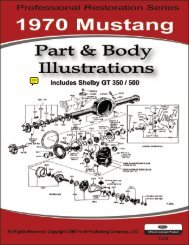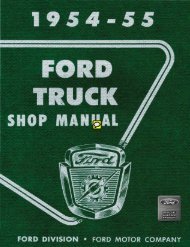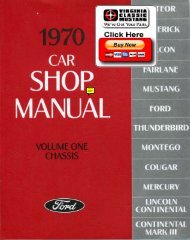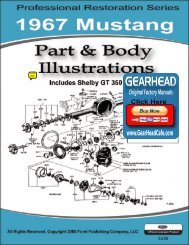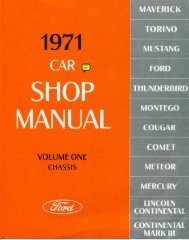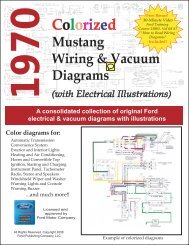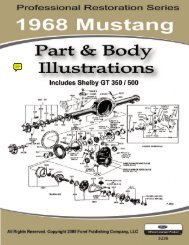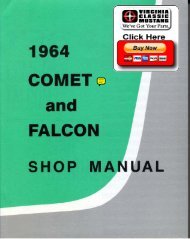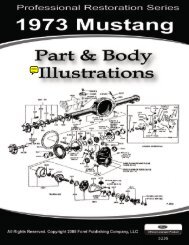DEMO - 1965 Ford Truck Shop Manual - ForelPublishing.com
DEMO - 1965 Ford Truck Shop Manual - ForelPublishing.com
DEMO - 1965 Ford Truck Shop Manual - ForelPublishing.com
Create successful ePaper yourself
Turn your PDF publications into a flip-book with our unique Google optimized e-Paper software.
2-82 GROUP 2-BRAKES<br />
applies pressure to the shoe web to<br />
avoid cocking the shoe.<br />
3. Install the shoe retracting<br />
springs.<br />
4. Install the wheel, hub, and<br />
drum assembly. If equipped with<br />
Fail-Safe Units, turn the release bolt<br />
counterclockwise (approximately 18<br />
turns) to release the manual <strong>com</strong>pression<br />
of the actuating spring.<br />
FOOT CONTROL VALVE<br />
The brake valve has two tiers of<br />
four ports each (Figs. 17 and 19).<br />
The lower tier of ports connects to<br />
the reservoir pressure lines; the upper<br />
tier connects to the lines carrying<br />
brake service pressure. Of the four<br />
lower ports, one receives reservoir<br />
pressure; one sends reservoir pressure<br />
to the governor; and the other two<br />
(depending upon the model) either<br />
send reservoir pressure to some other<br />
part of the system, or they are plugged.<br />
On tractors, for example, the<br />
trailer emergency line connects to<br />
one of these ports in order to carry<br />
tractor reservoir pressure to the trailer<br />
reservoir.<br />
One of the four upper ports sends<br />
valve delivery pressure to the stop<br />
light switch. Any or all of the three<br />
remaining ports (depending upon the<br />
model) can be used to deliver service<br />
pressure to the brake chambers<br />
or to the trailer. Any unused ports<br />
are plugged.<br />
F-, B-, C-, N-, and T-SERIES<br />
TRUCKS<br />
REMOVAL<br />
1. Open the reservoir drain<br />
cock(s) to exhaust the system.<br />
STOPLIGHT SWITCH<br />
BRAKE SERVICE LINE<br />
2. Disconnect all but one line<br />
from the valve ports (Fig. 17). Loosen,<br />
but do not disconnect, the remaining<br />
line. This line will prevent<br />
the valve from falling when the retaining<br />
bolts are removed.<br />
3. Remove the cotter key and pivot<br />
pin that connect the brake treadle<br />
to the control valve mounting plate.<br />
4. Remove the three control valve<br />
retaining bolts (Fig. 18).<br />
5. Disconnect the remaining air<br />
line from the control valve and remove<br />
the control valve.<br />
INSTALLATION<br />
1. If a replacement valve is being<br />
installed, transfer all brass fittings<br />
and the stop light switch to the replacement.<br />
Apply sealer to the<br />
threads before installation.<br />
2. Remove the actuating button<br />
and the rubber seal from the control<br />
valve mounting plate to facilitate<br />
the positioning of the new valve<br />
(Fig. 18).<br />
3. Position the new valve to the<br />
lower dash panel and mounting<br />
plate, then install three retaining<br />
bolts.<br />
4. Install the actuating button in<br />
the mounting plate bore, then install<br />
the rubber seal to the button and<br />
mounting plate.<br />
5. Assemble the brake treadle to<br />
the control valve mounting plate<br />
with the pivot pin and cotter key.<br />
6. Connect the stop light wires<br />
ACTUATING TREADLE PIVOT<br />
SEAL BUTTON BRAKE PIN<br />
(two nuts and flat washers), and connect<br />
the battery cable (Fig. 17).<br />
7. Connect the brake service<br />
line(s) to the upper ports in the<br />
valve.<br />
8. Connect the <strong>com</strong>pressor governor<br />
line and the reservoir pressure<br />
line(s) to the lower ports in the<br />
valve.<br />
9. Start the engine to build up<br />
pressure. Check for leaks.<br />
H-SERIES TRUCKS<br />
Removal<br />
1. Open the reservoir drain cock(s)<br />
to exhaust the system.<br />
2. Disconnect the <strong>com</strong>pressor governor<br />
line and the reservoir pressure<br />
line(s) (Fig. 19).<br />
3. Disconnect the brake service<br />
line(s).<br />
4. Disconnect the battery cable,<br />
then disconnect the two wires from<br />
the stop light switch (Fig. 8).<br />
5. Disconnect the control valve actuating<br />
arm from the valve mounting<br />
bracket by removing the cotter pin<br />
and clevis pin (Fig. 19).<br />
6. Remove the three retaining<br />
bolts and the valve assembly from the<br />
mounting bracket.<br />
Installation<br />
1. If the valve is being replaced,<br />
transfer all brass fittings and the<br />
stop light switch to their corresponding<br />
ports on the replacement valve.<br />
Apply sealer to the threads before installation.<br />
BRAKE LINE<br />
GOVERNOR LINE<br />
PRESSURE LINES GOVERNOR H1140-A<br />
FIG. 17-Typical Foot Control<br />
Valve Installation<br />
RETAINING<br />
BOLTS<br />
CONTROL<br />
VALVE<br />
MOUNTING<br />
PLATE<br />
VALVE<br />
RETAINING<br />
BOLT<br />
H1187-A<br />
FIG. 18-Brake Treadle and<br />
Mounting Plate<br />
LINES<br />
H1136-A<br />
FIG. 19-H-Series Brake Valve<br />
Installation




